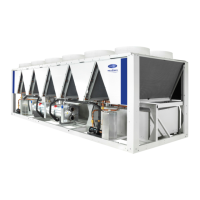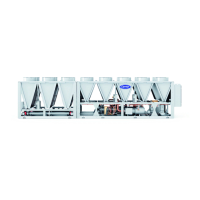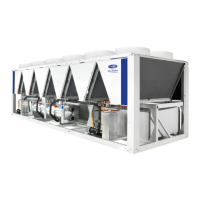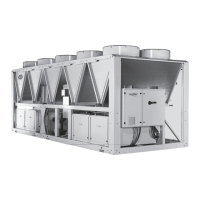345
APPENDIX J — FACTORY-SUPPLIED PUMPS (cont)
Fig. T — Administrative Settings
Sequence of Operation
The sequence of operation is covered in the steps below.
Pumps will start with a closed contact from the pump relay
across the “DIG IN 1” input on the pump control board. This
contact is wired to all pumps in parallel. At start the pumps will
go to 50% of max speed.
After 30s of run time, the pump control will calculate the num-
ber of pumps and speed required to meet the required flowrate
and head. Only pumps in “Auto” mode will be used in this op-
eration. All pumps may not be used by the pump controller de-
pending on flow requirements and most efficient operating
point.
If all pumps are not running, but in “Auto” mode, the controller
will sequence the pumps for even runtime. The pump rotation
time is adjustable in the pump controller.
If a pump fails or one is set to the “Off” mode, another pump
will start if available. If additional pump is not available, the
speed of remaining pumps will be increased to meet the load.
Alarms
The following alarms may present at the pump display. The
alarm descriptions are not communicated to the chiller control
so they must be checked at the pump system. The chiller moni-
tors the alarm relay on each pump. If all of the pumps are in
alarm, not functional, the chiller will shut down and show a
“pump failure” alarm. See Tables A and B.
Table A — Alarms
BIT POSITION NAME ALARM DESCRIPTION
0 VFD Over temperature
The temperature of a VFD or motor component is exceeding the thermal alarm limit. Turn off the power to the pump and ver-
ify that the motor, fan, and VFD cooling is functioning correctly. Verify that the pump is not overloaded. Wait until hot compo-
nents have cooled before returning to service and if the alarm persists after powering up, contact an Armstrong Technical
Service representative.
1 VFD Over Current
The VFD has detected current exceeding the safe limit. Turn the pump off. (If there is a discharge from the output phases to
earth it can be verified by checking for any faults with a megohmmeter between ground and the motor leads.) If a current limit
has been exceeded in the VFD check that the motor can be turned. If the pump is being overloaded reduce the pump speed
using hand mode control. If the alarm persists after powering up, contact an Armstrong Technical Service representative.
2 External VFD Voltage
The voltage into the VFD is out of range. Verify that the correct voltage required to operate the VFD is present by measuring
each of th three phases. If the alarm persists after cycling power to the pump, contact an Armstrong Technical Service repre-
sentative.
3 Internal VFD Voltage
An internal voltage generated by the VFD is out of range. If the alarm persists after cycling power to the pump, contact an
Armstrong Technical Service representative.
4 Internal VFD
An internal error in the VFD has occurred. If the alarm persists after cycling power to the pump, contact an Armstrong Tech-
nical Service representative.
5 VFD Parameter
One or more of the parameters to control the VFD is not correct. Check the settings on the control card. If the alarm persists
after cycling power to the pump, contact an Armstrong Technical Service representative.
6VFD Startup
An error occurred during the start-up of the motor. Turn off the power to the pump and verify that the motor can be turned by
using hand mode control. If the alarm persists after powering up, contact an Armstrong Technical Service representative.
7Other VFD
There has been an unknown alarm condition generated by the VFD. If the alarm persists after cycling power to the pump,
contact an Armstrong Technical Service representative.
8 VFD Communication
There is a communication issue between the control card and the VFD. Turn off the power to the pump and check the con-
nectors between the control card and the VFD.
9VFD Speed
The speed set by the VFD is not within tolerance. If the alarm persists after cycling power to the pump, contact an Armstrong
Technical Service representative.
10 Reserved
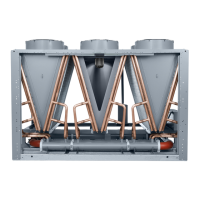
